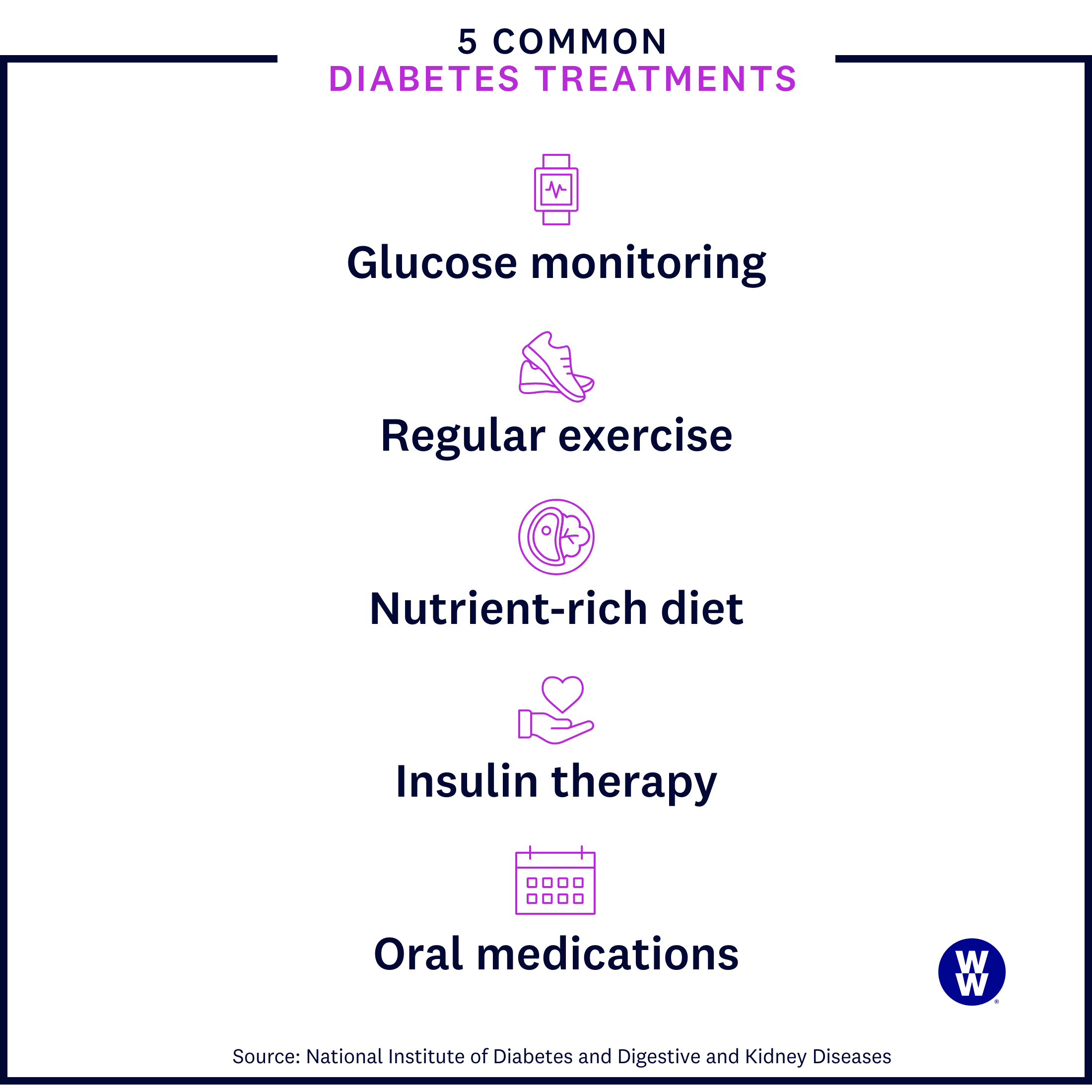Diabetes treatments


What is diabetes exactly?
In order for food to become energy, your body breaks down whatever you eat into glucose, or blood sugar. That glucose is used to fuel all the systems in your body. But you need insulin (a hormone produced by your pancreas) for that glucose to get from the bloodstream into your cells.
If you have diabetes, that system doesn’t work efficiently. Your body either doesn’t produce insulin at all (type 1 diabetes) or doesn’t use its insulin correctly (type 2 diabetes). The result: Blood sugar levels rise, potentially leading to some serious complications like chronic kidney disease, vision loss, and heart disease.
The main goal of diabetes treatments is to help manage blood sugar, minimising the impact the condition has on your body. Here are the different devices, medications, and lifestyle changes that do just that.
How is diabetes treated?
The diabetes treatment that’s right for you largely depends on the type of diabetes you have, how severe it is, and what your doctor recommends based on your unique health history. That said, treatment plans tend to have a multi-pronged approach made up of the following.
Glucose monitoring
Maintaining normal blood sugar levels is key to reducing your risk of complications. One critical step is checking your blood sugar throughout the day (your healthcare team will tell you how often you need to do it). This helps you and your doctors see just how well your treatment plan is working and then make any necessary adjustments.
Glucose monitoring can be done with a finger prick/glucose metre (you poke your finger and put a drop of blood on a test strip) or with a continuous glucose monitor (a wearable device attached to your skin that measures glucose in real time and transmits the results to your smartphone).
Insulin
Insulin therapy—when additional insulin is injected into your body via a needle, pen, or pump delivery system—can be a crucial piece of the treatment puzzle for all types of diabetes. But it’s particularly important for people with type 1 since their bodies aren’t producing any on their own. Insulin is needed for the body to absorb and produce glucose efficiently.
“It’s similar to a lock and key, where insulin is the key that unlocks glucose and allows it to enter the cells and be used by the body,” says Nicole Lynch, a clinical nurse at the University of Utah Diabetes and Endocrinology Center, United States.
There are different types of insulin, which vary according to how fast they work and how long they last:
- Rapid-acting insulin begins to work about 15 minutes after injection and is effective for about 2 to 4 hours.
- Regular or short-acting insulin begins to work about 30 minutes after injection and is effective for about 3 to 6 hours.
- Intermediate-acting insulin begins to work about 2 to 4 hours after injection and is effective for about 12 to 18 hours.
- Long-acting insulin begins to work several hours after injection and is effective for about 24 hours.
- Ultra long-acting begins to work about 6 hours after injection and is effective for about 36 hours or longer.
Oral medication
Oral diabetes medications can be another helpful tool in managing blood sugar levels. Among the different types your doctor may prescribe:
- Sulfonylureas help the pancreas release more insulin, which lowers blood sugar.
- Biguanides reduce the amount of blood sugar produced by the liver, improve how insulin works in the body, and slow the process of converting carbs to sugar.
- Thiazolidinediones increase how much glucose goes into muscles, fat, and the liver, which makes insulin work more efficiently.
- Alpha-glucosidase inhibitors delay the body’s breakdown of carbs, lowering blood sugar.
- Meglitinides enable the pancreas to release more insulin, lowering blood sugar.
- DPP-4 inhibitors help your pancreas release more insulin after meals and lower the amount of blood sugar released by the liver.
- SGLT2 inhibitors act on the kidneys to remove extra sugar from the body.
- Bile acid sequestrants lower cholesterol and blood sugar levels.
- Dopamine agonists lower the amount of glucose the liver produces.
What lifestyle changes can help manage diabetes?
Research suggests that higher weight-loss levels could result in diabetes remission for those with type 2 diabetes, which is defined as HbA1c (also called A1c) levels—a measure of how well you’re controlling your blood sugar—staying below 6.5% for at least three months without glucose-lowering medication. In a study of younger adults recently diagnosed with type 2 diabetes, 61% of people who lost an average of 11.9% of their weight had their diabetes go into remission.
That’s where a plan like the WeightWatchers® diabetes program comes in. People with type 2 diabetes who followed the plan for six months lost an average of 5.7% of their body weight and significantly improved their HbA1c levels.

Tell me more about...
lifestyle changes
lifestyle changes
Q: How much exercise will make a difference?
A: Being physically active doesn’t mean hard-core exercise. Diabetes Australia recommends at least 30 minutes of moderate intensity physical activity every day. This helps lower insulin resistance.
Because diabetes can cause a drop in blood sugar when exercising, it’s important to talk to your doctor about when you should check your glucose levels during physical activity.
Q: Is there such a thing as a diabetes diet?
A: “A healthy eating plan can optimise blood sugar control and decrease insulin resistance,” says Barbra Sassower, RDN, a registered dietitian nutritionist, certified diabetes education specialist, and WW certified diabetes educator. That said, there’s no magic diet that can eliminate diabetes, but Diabetes Australia recommends a diet high in non-starchy vegetables and whole foods with minimal added sugars, refined grains, and processed foods.
The WW diabetes program has taken those recommendations and built them into the Points system, making it easier for members living with diabetes to follow those guidelines and reach their health goals.
Q: OK, exercise and diet—check. Anything else?
A: Make sure you’re getting rest! Studies show that adults with diabetes often have a harder time sleeping than those without the disease. Unfortunately, sleeping less than 6.5 hours per night is linked to having higher blood sugar levels than those who routinely get more shut eye. If you’re always tired, try see a sleep specialist who can determine if you have a sleep disorder like sleep apnea (which people with diabetes are at a higher risk for).
Also, don’t forget to tend to your emotional wellbeing. Consider working on self-compassion; which early findings show can reduce diabetes distress while also improving blood sugar regulation. A foundation of the program, self-compassion involves learning to respond to yourself with gentleness instead of judgement, and finding healthy ways to comfort yourself when you feel upset.

How are the different types of diabetes treated?
While blood sugar monitoring, insulin therapy, oral medications, and lifestyle modifications can be used to treat any kind of diabetes, there are some ways treatments vary depending on if you have type 1, type 2, or gestational diabetes.
Type 1 diabetes
Focusing on insulin: With type 1 diabetes, your body doesn’t produce insulin at all. That’s why everyone with type 1 has to have insulin therapy, usually a combination of shorter-acting insulin before you eat and a longer-acting formulation at night. The amount of insulin depends on your weight, with higher amounts needed during certain events like puberty, pregnancy, and illness.
Sticking to an eating schedule: Beyond following a healthy diet, those with type 1 diabetes can benefit from eating at the same times each day and consuming a consistent amount of carbs. This is because they are more likely to be taking specific amounts of insulin at the same time every day. When you’re on a schedule like that, a consistent eating pattern can help control blood sugar.
Gestational diabetes
Treating gestational diabetes—a form of high blood sugar that happens specifically during pregnancy—can be tricky. “Part of the difficulty in treating gestational diabetes is that blood glucose targets are even lower than normal,” Lynch says. “That said, a large majority of women who have gestational diabetes are able to manage it by monitoring carbohydrate intake and increasing exercise to reduce insulin resistance. ”Certain brands of insulin are safe to use in pregnancy, but others haven’t been studied yet in pregnancy, she says.
Type 2 diabetes
Starting with oral medication to improve insulin resistance: Because people with type 2 diabetes are still making insulin, doctors often prescribe oral medications to help the body use its insulin better, according to Lynch. This allows them to improve blood sugars without going on insulin (something that would be impossible for someone with type 1 diabetes). A drug known as Metformin, which is a biguanide, is often used as the go-to oral treatment for type 2 diabetes before any other medications are considered since it tends to work well with few side effects.
Bringing in insulin if needed: If blood sugar is still difficult to control with lifestyle changes and oral medications, insulin may be added to the mix. A sign you need insulin is if your HbA1c levels (a blood test that measures your average blood sugar levels over the previous three months) are greater than 9%. It’s common to start with intermediate-acting or long-acting forms, which are taken either in the morning or at bedtime, to keep blood sugar controlled throughout the day. But because type 2 diabetes is a progressive disease that can continue to cause the body to produce less insulin over time, some people may ultimately need a more complex insulin approach.
Losing weight: As mentioned above, losing weight through a healthy diet and increased physical activity is especially important for people with type 2 diabetes because it can improve blood sugars and, in some cases, put the disease into remission.
Can diabetes be cured?
While there’s no cure for type 1 diabetes, gestational diabetes tends to go away after delivery and type 2 diabetes can go into remission—that means you won’t show any signs of the condition or need any medication. Studies have shown that losing weight and keeping it off is significantly associated with diabetes remission. The greater the weight loss, the higher your chances of having the disease go into remission.
What qualifies as type 2 diabetes remission?
Partial remission | fasting glucose range measuring less than 5.6-6.9 mmol/L (HbA1c below 6.5%) for at least one year with no medication |
Complete remission | fasting glucose range measuring less than 5.6 mmol/L (HbA1c below 5.7%) for at least one year with no medication |
Prolonged remission | fasting glucose range measuring less than 5.6 mmol/L (HbA1c below 5.7%) for at least five years with no medication |
How do you know if your diabetes treatment isn’t working?
Ideally, your treatment plan would do exactly what it’s supposed to do—manage your blood sugar. But sometimes it stops working, which is why it’s important to keep an eye on key numbers. “Understanding your glucose ranges by monitoring your blood glucose and having haemoglobin checked every 3 to 6 months as recommended by your provider can help you know if your diabetes treatment is working for you,” says Sudipa Sarker, M.D., associate professor of medicine at the Johns Hopkins University School of Medicine, and the director of the Johns Hopkins Inpatient Diabetes Management Service, United States. Your provider will likely aim for HbA1c less than 7%.
Having regular check-ins with your healthcare team is the most important thing you can do to make sure your treatment plan is working as well as it should. There are many different treatment options and your doctor will be able to adjust which ones you’re using to keep you as healthy as possible.
This content is for informational purposes only and does not constitute medical advice, diagnosis or treatment. It should not be regarded as a substitute for guidance from your healthcare provider.
